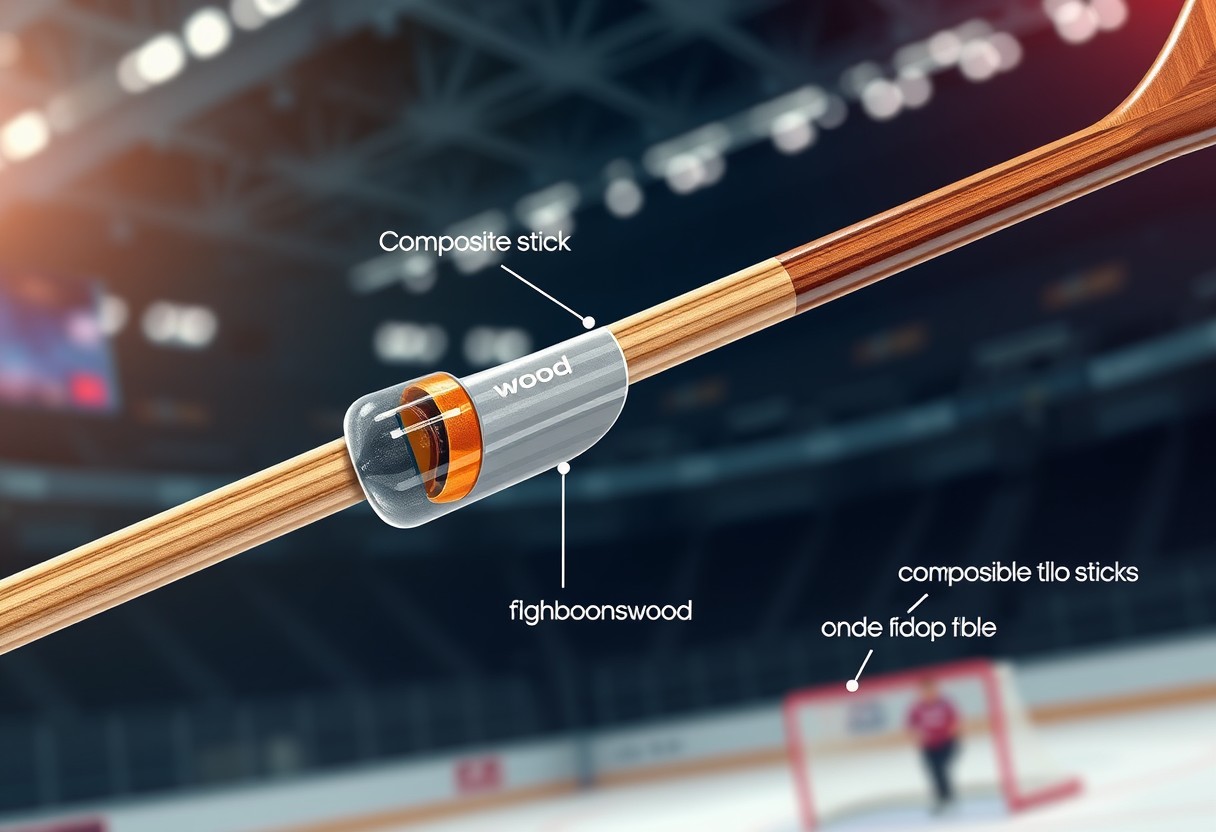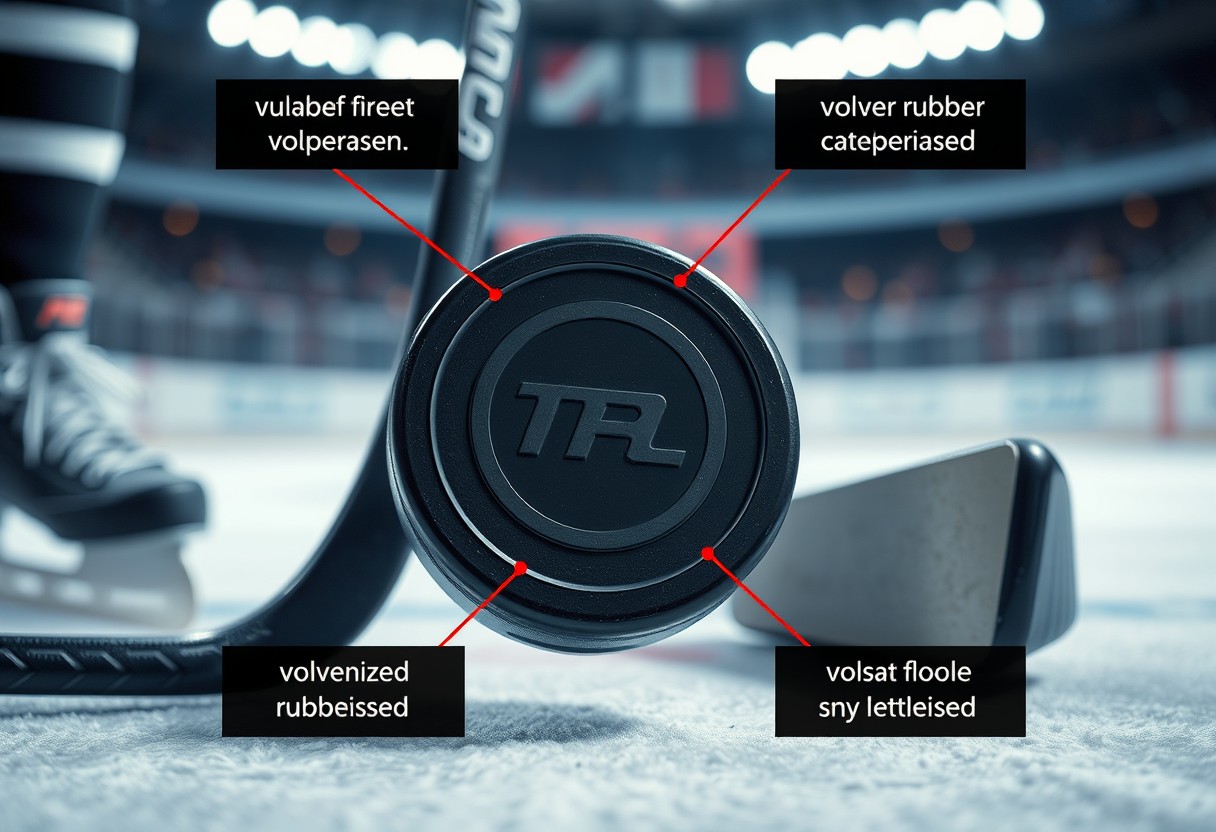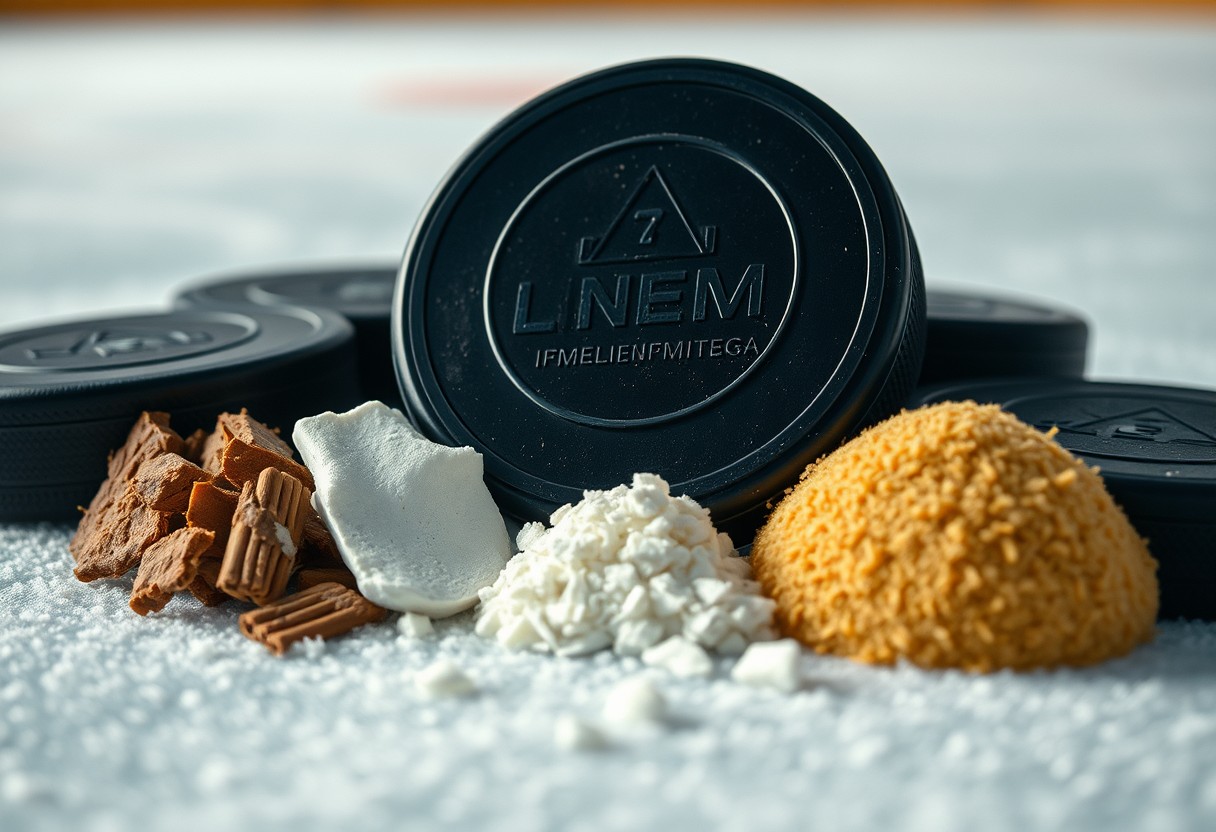Wood is one of the traditional materials used in hockey stick manufacturing, but it’s far from the only option available to you. In today’s game, hockey sticks come in various materials, each offering unique advantages that can enhance your performance on the ice. Understanding what hockey sticks are made of will help you choose the right one that complements your playing style and preferences. Whether you’re a beginner or a seasoned player, knowing the materials will guide your decision-making process when investing in your next stick.
Key Takeaways:
- Materials: Hockey sticks are primarily made from wood, composite materials, or aluminum, each offering different advantages in terms of performance and durability.
- Wood Sticks: Traditional and often preferred by beginners, wood sticks provide feel and control but can be heavier and less durable compared to newer materials.
- Composite Sticks: Made mainly from fiberglass, carbon fiber, and kevlar, composite sticks are lightweight, offer better performance, and are designed for advanced players.

History of Hockey Stick Materials
The history of hockey stick materials is as rich and varied as the game itself. As you examine into this topic, you’ll discover how changes in materials have profoundly influenced the performance, durability, and even the play style of hockey. Initially, hockey sticks were crafted from simple, natural materials, but as the sport evolved, so did the technology and resources utilized for their construction.
Early Materials Used
Early hockey sticks were primarily made from wood, a material that was readily available and easy to work with. Ash and birch were among the most commonly used woods, providing a balance of strength and flexibility vital for players to handle the puck effectively. The traditional wooden stick was hand-carved, and players had a strong connection to their equipment, often customizing the curvature or length to suit their individual playing style.
As the game grew in popularity, manufacturers began experimenting with different types of wood, enhancing the stick’s performance. For instance, the introduction of laminated woods allowed for more consistency and durability. Despite these advancements, wood remained the dominant choice for many decades, as players valued the feel and feedback it provided during gameplay.
Transition from Wood to Composite
Materials and technology began to shift dramatically by the late 20th century as players sought out equipment that could deliver better performance. The transition from traditional wood to composite materials marked a significant evolution in hockey stick design. With the introduction of fiberglass, carbon fiber, and Kevlar, sticks gained lighter weights and improved strength, offering players a competitive edge.
Stick manufacturers developed new technologies that allowed for precise engineering, resulting in sticks that could flex more during shots and provide an enhanced energy transfer. This transformation not only changed the materials used but also how you perceive the sport itself. Today, composite sticks dominate the market and are available in various models that cater to every player’s needs, blending performance with modern manufacturing capabilities. Embracing these innovations might change your playing style and improve your overall game experience.

Types of Materials Used in Hockey Sticks
One of the most critical aspects of ice hockey is the stick, as it plays a significant role in your performance on the ice. When deciding on a stick, you might be surprised to learn there are various materials used in their construction. Understanding these materials can help you make an informed decision that optimally suits your playing style and preferences. Below are the primary types of materials used in hockey sticks:
| Material | Description |
|---|---|
| Wood | Traditional sticks offer a classic feel, often preferred by players who enjoy a natural touch. |
| Composite Materials | Modern sticks utilizing a blend of materials for improved durability and performance. |
| Aluminum | Lightweight and durable, aluminum sticks are often suited for recreational play. |
| Fiberglass | Commonly used in conjunction with wood or composite for added strength. |
| Carbon Fiber | A high-performance material offering stiffness while remaining lightweight. |
The materials you choose can dramatically alter your playing experience and effectiveness. Typically, a combination of these elements leads to a stick that caters to your specific requirements, whether that be power, finesse, or durability.
Wood
Sticks made from wood have long been used in hockey for their unique balance of flexibility and control. While they may not have the same durability as their composite counterparts, many players enjoy the traditional feel that wood sticks provide. They can absorb shocks and offer excellent puck-handling capabilities, making them a favored choice among recreational players and those who appreciate the classic aspects of the game.
However, wood sticks do have their downsides. They tend to wear out faster than modern materials, and the quality can vary significantly depending on the type of wood used. Nevertheless, if you prefer a stick that offers a tactile experience and connect you to the game’s roots, wood sticks might be the right option for you.
Composite Materials
Materials used in composite sticks typically include a blend of carbon fiber, fiberglass, and sometimes Kevlar. These sticks are designed to be lightweight yet incredibly strong, providing you with enhanced performance on the ice. One key advantage of composite sticks is their ability to store and release energy during a shot, which can significantly increase shot power and accuracy. Additionally, their durable construction helps resist damage from impact, making them a popular choice among advanced players.
With various designs and flex options available, composite materials can cater to your playing style. Whether you’re someone who prefers a low kick point for quick wrist shots or a mid kick point for powerful slap shots, you’ll find a composite stick that complements your technique.
The diversity in composite materials allows manufacturers to create sticks with specific properties, offering a tailored fit to enhance your game.
Aluminum
For those looking for a durable and lightweight option, aluminum sticks are often an appealing choice. While traditionally used more in street hockey and recreational play, aluminum sticks provide a good mix of weight and strength. You can rely on them for their resilience, making them suitable for various conditions and playing styles. However, they might not offer the same level of performance and feel that you would experience with composite options.
In contrast to wooden and composite sticks, aluminum sticks have less flexibility and can feel less responsive on the ice. They are designed for longevity, which is a critical factor if you are a casual player looking for a reliable stick without frequent replacement. Thus, aluminum sticks provide an efficient blend of durability and performance for your hockey experience.
Wood sticks remain a classic choice for those who appreciate the traditional aspects of hockey. While they may not be the most durable option available, their feel and control can make all the difference in your gameplay.
Construction of Hockey Sticks
All hockey sticks are not created equal; their construction significantly affects your game. From the materials used to the manufacturing processes involved, a variety of factors contribute to the performance, durability, and feel of the stick you choose. Understanding how hockey sticks are constructed can help you make informed decisions about what will best meet your playing style and needs.
Manufacturing Processes
The manufacturing processes of hockey sticks can vary depending on the materials used, but most modern sticks are built from composites, primarily consisting of carbon fiber, fiberglass, and a resin system. These materials are combined using advanced techniques such as molding and layup processes, which not only ensure the stick is lightweight but also provides it with the necessary strength and flexibility. Automated machinery and skilled craftsmen collaborate to ensure precision in every aspect of production, impacting the stick’s balance and overall performance.
Additionally, some manufacturers opt for fusion techniques, where different materials are layered to enhance performance aspects like shooting power and durability. After the initial laying out of materials, the sticks undergo curing, where heat is applied to strengthen the bonding of the materials. The final product is rigorously tested to ensure it meets the high standards needed for performance on the ice, giving you a stick that can withstand intense gameplay.
Design Elements
An important aspect of hockey stick construction is the design elements, which play a crucial role in how the stick performs. From the shape of the blade to the curvature of the shaft, every detail is engineered to enhance your playing experience. The flex of the stick, which refers to how much it bends when under pressure, can influence your shooting power and accuracy. Choosing the right flex for your weight, height, and playing style allows you to optimize your performance on the ice.
Elements such as the blade pattern, grip texture, and overall weight distribution are also key to how a hockey stick feels in your hands. A well-designed stick will offer you the right amount of control and responsiveness while still being comfortable to handle during gameplay. You should also consider how the design of the stick aligns with your specific techniques, whether you’re a power shooter or someone who relies on finesse, as this can make a difference in your overall effectiveness as a player.
Performance Characteristics of Materials
Your choice of material significantly impacts the performance of a hockey stick, influencing everything from weight to durability. Understanding these characteristics can help you select the right stick to enhance your gameplay, maximize your efficiency on the ice, and ultimately improve your overall experience. Here are some key performance characteristics that you should consider when evaluating hockey stick materials.
Weight and Balance
On the ice, having a lightweight hockey stick can provide you with the agility you need for quick maneuvers and fast shots. Advanced materials like carbon fiber and composite blends offer lower weight without sacrificing strength, giving you the best of both worlds. A well-balanced stick allows you to execute play with precision. This balance means the weight is distributed evenly, making it easier for you to handle and shoot the puck effectively.
On the other hand, heavier sticks might offer more durability but can hinder your performance if you’re looking for speed and quick reflexes. Therefore, when evaluating a stick, consider not only its weight but also how it feels in your hands during different gameplay situations.
Shock Absorption
An crucial performance characteristic of hockey sticks is their ability to absorb shock. The right materials can minimize the impact of stick handling and puck contact, ensuring that your hands and wrists experience less stress during play. This is particularly beneficial during hard shots or when battling with opponents, as a stick with good shock absorption properties can help reduce vibrations, leading to improved comfort and control.
Performance is key here; the better the shock absorption, the more energy you can channel into your shot rather than dissipating it through vibrations. Materials such as foam cores or impact-resistant composites tend to excel in this area, leading to a more enjoyable playing experience.
Durability
Any player knows that durability is a crucial consideration when selecting a hockey stick. Sticks are subject to constant stress, rapid movements, and collisions, meaning they must withstand a lot of wear and tear. Materials like high-grade carbon fiber and reinforced composites are engineered for resilience, providing you with a stick that can endure long-term use and maintain its performance characteristics over time.
Additionally, some hockey sticks incorporate specific design elements, such as reinforced shafts or unique layering techniques, to enhance their durability further. This ensures that not only does the stick last longer, but it also retains its performance, providing you with reliable equipment until the end of its lifespan.
Puck Feel
Balance in your stick plays a vital role in how you feel the puck on your blade. A stick that provides excellent puck feel allows you to maintain better control and make quick, accurate passes or shots. Materials that offer responsiveness help transmit the puck’s presence, enhancing your awareness of its position while ensuring a smooth connection as you handle and shoot.
Absorption of shock is also intertwined with puck feel, as sticks that effectively minimize vibrations can provide clearer feedback when you make contact with the puck. Selecting a stick that balances these qualities can elevate your performance and improve your confidence while playing.
Understanding the characteristics of your hockey stick materials ensures you can make informed decisions. When you find the right stick for your game, you’ll notice an increase in performance and comfort, enhancing your overall enjoyment on the ice.
Environmental Impact of Hockey Stick Manufacturing
Once again, the manufacturing processes involved in creating hockey sticks can have significant environmental implications. The materials employed, from wood to composites, not only impact the performance of the stick but also pose various sustainability challenges. It’s crucial to consider these factors, especially as players and consumers become more conscious of the ecological footprint of their sporting equipment.
Sustainability of Wood Sources
Any time you pick up a wooden hockey stick, you’re participating in a long-standing tradition. However, that tradition comes with a responsibility to understand where the wood is sourced. Many manufacturers obtain their materials from forests that are not sustainably managed, leading to deforestation and loss of biodiversity. When you choose a wooden stick, you should look for brands that certify their wood is sourced from sustainably managed forests, ensuring that it comes from renewable resources and does not contribute to environmental degradation.
As you investigate further into the sustainability practices of manufacturers, you’ll find that some companies are now adopting innovative approaches to sourcing wood. These may include using reclaimed wood or partnering with sustainable forestry initiatives to ensure that their production practices do not harm the planet. Being informed about these practices allows you to make more conscious decisions when selecting your equipment.
Recyclability of Composite Materials
Sustainability is not just about sourcing; it also extends to the lifecycle of the materials used in hockey sticks. Most modern hockey sticks are made from composite materials that combine different fibers for enhanced performance. However, one of the downsides of these advanced materials is that they often do not break down after their useful life. This can lead to significant amounts of waste in landfills, posing an environmental challenge that you must consider when purchasing a new stick.
Understanding the recyclability of composite materials is key to minimizing your ecological footprint. While some companies are beginning to explore methods for recycling these composites, the infrastructure and technology to effectively do so are still in their infancy. Consequently, your choice of stick affects not just performance but also the long-term impact on the environment.
Eco-Friendly Alternatives
Composite materials are not the only option available to you as a hockey player. In recent years, eco-friendly alternatives have emerged in response to growing environmental concerns. These alternatives may include sticks made from biodegradable materials or those utilizing environmentally friendly manufacturing processes. By opting for these products, you can enjoy the sport you love while also contributing to more sustainable practices in the industry.
Hockey sticks that prioritize environmental responsibility often feature components derived from organic materials or recycled sources, which reduces reliance on virgin raw materials. You might also find that some brands focus on environmental certifications, providing peace of mind that the stick you choose is responsibly produced. Ultimately, choosing eco-friendly alternatives not only enhances your performance but also supports a healthier planet. By making informed choices, you contribute to a more sustainable future in hockey.
Choosing the Right Hockey Stick
Now that you understand the various materials used in hockey sticks, it’s imperative to choose the right one for your game. Making the right selection can significantly impact your performance on the ice. The perfect stick not only enhances your gameplay but also complements your style and technical abilities. When choosing a hockey stick, it’s critical to consider several factors that can affect your overall experience.
Factors to Consider
For optimal performance, you should pay attention to various factors while selecting your hockey stick. Firstly, consider the level of play; whether you are a beginner, intermediate, or advanced player, the type of stick you need will vary. Secondly, think about the length of the stick, as this plays a crucial role in your control and comfort. Additionally, flex rating is another imperative element to consider; this will affect how much power you generate during shots.
- Player level (beginner, intermediate, advanced)
- Stick length and height
- Flex rating for shot power
- Blade curve and pattern
- Weight distribution and balance
After considering these factors, you can make a more informed decision on the right hockey stick to suit your unique playing style.
Popular Brands and Their Offerings
Consider the major brands available in the market when selecting your hockey stick, as they often offer a variety of options tailored to different player preferences. Each brand has a unique focus, from lightweight constructions to specialized flex patterns that can improve shot power and accuracy. Some of the well-known brands include CCM, Bauer, and Warrior, each boasting a wide array of products designed for different skill levels and playing styles.
Their product offerings often cater to various aspects such as durability, grip comfort, and lightness, giving you multiple choices tailored to your specific needs. By examining the different models and features, you can find a stick that aligns perfectly with your style of play, ensuring that you perform at your best on the ice.
Care and Maintenance of Hockey Sticks
To ensure that your hockey stick performs at its best, proper care and maintenance are crucial. This not only enhances your game but also extends the life of the stick. By following a few simple steps, you can keep your equipment in prime condition and ready for action whenever you hit the ice.
Storage Recommendations
The way you store your hockey stick can significantly affect its longevity. It’s best to keep your stick in a temperature-controlled environment, as extreme heat or cold can warp the materials. Ideally, you should store your stick vertically, either in a dedicated bag or using a rack. Avoid leaning it against walls or heavy objects that could cause pressure points or bends.
Also, be mindful of keeping your stick away from direct sunlight for prolonged periods, as UV exposure can weaken the composite materials over time. If you’re planning a lengthy period without use, it’s a good idea to remove any tape on the blade to avoid moisture accumulation, which can lead to decay.
Repairing Minor Damage
Repairing minor damage to your hockey stick can save you money and keep the stick performing well. For small cracks or chips on the blade or shaft, using a specialized epoxy or resin suitable for composite materials can offer a quick fix. Make sure to clean the damaged area thoroughly before applying the repair adhesive, following the manufacturer’s instructions carefully for the best results.
You should regularly inspect your stick for signs of wear, especially after intense practices or games. If you notice any visible cracks, it’s wise to address them promptly rather than waiting until they worsen, which could lead to a complete break. Always prioritize safety; if the damage affects your performance or you feel the stick may break, consider replacing it.
Hockey sticks can also benefit from periodic touch-ups with clear coat sprays to protect the craftsmanship and enhance overall durability. Investing a little time into minor repairs can go a long way in maintaining the integrity of your stick.
Lifespan of Different Materials
Maintenance practices can vary depending on the materials used in your hockey stick. Generally, wooden sticks tend to have a shorter lifespan, often lasting a season or two, while composite sticks can last longer due to their resilient structures. Factors influencing the lifespan include frequency of use, type of play, and how well you care for the stick. Following proper maintenance routines can significantly improve how long you can use your equipment.
It’s crucial to assess the type of stick you use and adjust your maintenance habits accordingly. Composite sticks, while generally more durable, can still suffer from issues like delamination or impact damage. Understanding these nuances allows you to take better care of your gear, ensuring that your hockey sticks serve you well over many seasons.
Final Words
Drawing together the elements that contribute to making hockey sticks, you can see that the choice of materials significantly affects your performance on the ice. From traditional wood to modern composite options like carbon fiber and fiberglass, each material offers distinct advantages and drawbacks. Understanding these options allows you to tailor your stick choice to your playing style, whether you prioritize durability, flexibility, or weight. Your personal preferences, as well as the level of play you aspire to, should guide your selection in order to maximize your effectiveness during games.
As you consider the options available, remember that the construction of hockey sticks has evolved considerably over the years, with advancements enhancing both performance and player satisfaction. Investing time to learn about these materials equips you with the knowledge to make an informed decision that aligns with your goals on the ice. Ultimately, whether you opt for a classic wooden stick or the cutting-edge technology of composites, the key is finding the right balance that complements your unique style of play.




